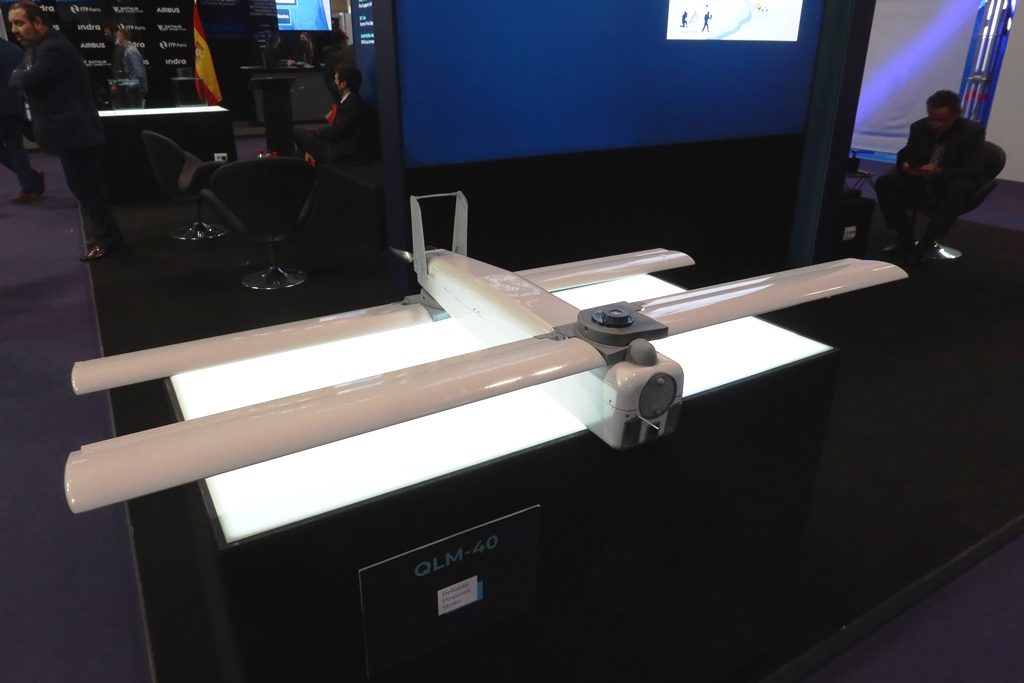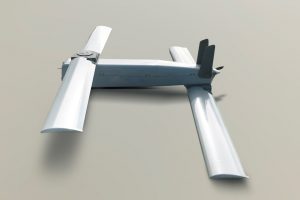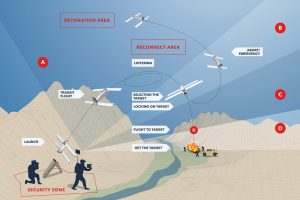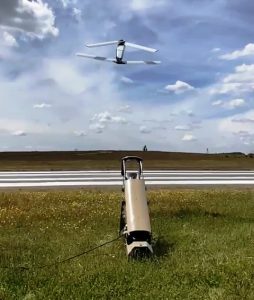
Arquimea Aerospace & Defence unveils its QLM-40 loitering munition
By Paolo Valpolini
Arquimea, a Madrid-based company involved in space, science, aeronautics and defence, unveiled at FEINDEF its QLM-40 loitering munition developed by its Aerospace & Defence business unit. A portable system, easily deployable by a two-man team, its has a 12 minutes endurance that gives has a range of 6 km in normal use and 10 km when flying directly towards a target with specific coordinates.
The airframe is made of fiberglass/epoxy with carbonfiber struts, while the wings are made of triple compound. The munition is launched from a tube that contains a pneumatic system allowing the airframe sufficient time to deploy wings and to start the electric motor. The launcher is 800 mm long, 250 mm wide and 400 mm high, and weighs 14.5 kg. The fuselage has a near-square section, with two pairs of wings. Front wings are hinged on top of the fuselage and folded backwards while rear wings are hinged under the fuselage and folded forward, while the two vertical stabilisers are tilted forward. A two-blade pushing propeller is located at the rear, blades being folded before launch, linked to the electric motor; moving forward in the fuselage we find the Lithium Ion batteries, the warhead, and the HD camera. The airframe is 0.72 meters long, has a 1.4 meters wingspan, and has a mass of 3.1 kg without warhead. “The latter is currently an Expal 40L70 ammunition,” Manuel Martín Flórez, Arquimea Aerospace & Defence business unit managing director told EDR On-Line; “this represents a low cost solution, cost being definitely a design driver as the QLM-40 is a one-shot system.” The pre-fragmented ammunition has a mass of around 1 kg and contains some 100 grams of explosive, hence the mass before flight is of 4.2 kg. The warhead is fitted with a fuse purposely developed by Arquimea, which can be activated and deactivated via data link.
The mission operator carries the rucksack that contains the data link system, the ruggedised tablet computer used as ground control station, the antenna, which is installed on a telescopic mast, and the launcher. When required he links up the tablet by cable to the data link and extends the antenna, while his colleague inserts the munition into the launch device. The launch operator carries three QLM-40, which can be transported ready to be used or with the warheads aside, depending on the operator’s choice. The mission operator then selects one of the available automatic flight modes or the manual piloted mode, and following a quick pre-flight check the QLM-40 is launched. The data link operates in the 2.4 GHz band and has an output power of 1 W, fully sufficient to cover the limited operating distance. The munition can be launched at a maximum altitude of 2,000 meters over sea level, and can fly at a maximum height over ground of 600 meters, at a maximum speed of 110 km/h. Once it reaches the target area, the QLM-40 enters in loitering mode, once again automatic or manual, flight level in this phase being between 20 and 200 meters above ground while loitering speed is 60 km/h. The operator at the GCS identifies the target thanks to the image obtained by the front TV camera, a Sony IMX290LQR-C, based on a STARVIS back-illuminated CMOS sensor featuring a high sensitivity capable to provide high picture quality in the visible-light and near infrared light regions. Once the target has been selected, the operator orders the attack mission and the munition flies towards the objective and detonates. The angle of attack varies according to the type of target. Should the mission be aborted, the QLM-40 is flown in a safe area where it is detonated.
“The QLM-40 development is in the very final stage,” Manuel Martín Flórez explains. The system development was carried out by Arquimea on company funds, and recently the Spanish Ministry of Defence selected the company to develop the short-range loitering munition system for the Army, “and we are currently carrying out minor customisations required by the MoD. This partnership between the Ministry and the company will be crucial for the evolution of the product, and will guarantee the total satisfaction of the final users.” The system has already been qualified by INTA (Instituto Nacional de Técnica Aeroespacial), the Spanish National Institute for Aerospace Technology, for all safety aspects, including loss of signal and alike. Arquimea is ready to integrate different warheads according to customers requirements, providing they respect the mass and size limits. The QLM-40 has already been tested in flight, both without and with the warhead.
Although the QLM-40 is in the early stage of its life, Arquimea is already looking at further developments. “We are developing a multiple launcher that can be installed on a vehicle, which will be available in the near future,” the Aerospace & Defence BU managing director announces, “and we are also working on the swarm concept, which will allow a single GCS to operate a half dozen munitions,” he adds, this allowing saturating attacks against defended targets. Further developments are also being considered for a later date, such as a bigger airframe capable to carry a heavier warhead.
Photos courtesy Arquimea and P. Valpolini






